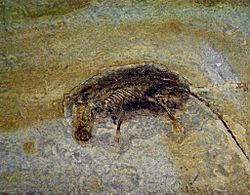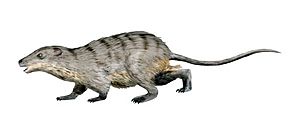Eomaia facts for kids
Quick facts for kids EomaiaTemporal range: Lower Cretaceous, 125 mya
|
|
|---|---|
 |
|
| Eomaia | |
| Scientific classification | |
| Kingdom: | |
| Phylum: | |
| Class: | |
| Subclass: | |
| Infraclass: | |
| Genus: |
Eomaia
Ji et al., 2002
|
| Species | |
|
|
Eomaia ('dawn mother') is an early fossil eutherian mammal. It is exceptionally well-preserved for a 125 million-year-old specimen.
It was discovered in rocks of the Yixian Formation, Liaoning Province, China. These strata date to the Lower Cretaceous about 125 million years ago (mya).
The fossil is 10 centimetres (3.9 in) in length and virtually complete. It weighed between 20–25 grams (0.71–0.88 oz). Although the fossil's skull is squashed flat, its teeth, tiny foot bones, cartilages and even its fur are visible.
Eomaia is a eutherian. The eutherians are the placental mammals plus some extinct mammals which had not developed a placenta.
What distinguishes the Eutheria from metatherians, a group that includes modern marsupials, are various features of the feet, jaws and teeth.
However Eomaia is not a true placental mammal as it lacks some features that are specific to placentals. Eomaia has:
- variations in the shin and ankles.
- an ancestral eutherian dental formula.
- a wide opening at the bottom of the pelvis, which allows the birth of large, well-developed offspring. Marsupials have and non-placental eutherians had a narrower opening that allows only small, immature offspring to pass through.
- Eomaia has epipubic bones extending forwards from the pelvis. These are not found in any placental mammal, but are found in all other mammals, even in the cynodont therapsids that are closest to mammals. Their function is to stiffen the body during locomotion. This stiffening would be harmful in pregnant placentals, whose abdomens need to expand.
Its discoverers sampled 268 characters from all major Mesozoic mammal clades and principal eutherian families of the Cretaceous period. As a result, they claimed Eomaia is at the root of the eutherian "family tree" with a few other fossils.
The Eomaia fossil shows clear traces of hair. However this is not the earliest clear evidence of hair in the mammalian lineage, as fossils of the docodont Castorocauda, discovered in rocks dated to about 164 mya, also have traces of fur.
Related pages
Images for kids
See also
 In Spanish: Eomaia para niños
In Spanish: Eomaia para niños





